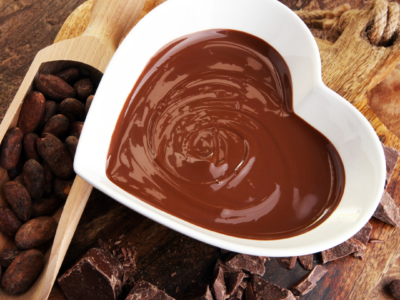No introductions are needed for this highly treasured food that dates back to 2000 BC. Can you believe that? Uh yeah! Are you a chocolate lover? Are you confused whether chocolate is good for you or bad? What kind should you buy? I am going to answer all of your questions in this article and more!
Did you know?
Chocolate is its very own food group! What? Seriously!
Well not really—but it seems as if it should be. Powerfully comforting, creamy, delicious—many people eat chocolate at least several times a week.
Which begs the question…
Is Chocolate Good for You?
The answer is both yes and no.
Chocolate has been used for centuries to treat bronchitis, sexual malaise, fatigue, hangovers, anemia, depression, memory loss, high blood pressure, poor eyesight, and more. It also helps release that feel-good neurotransmitter—serotonin—in the brain which is why you feel good after you eat it!
But eat the wrong kind and you’ll get loads of sugar, calories, and junky ingredients.
How to Eat it Responsibly
Chocolate begins life as raw cacao (pronounced kah-kow) beans (now ya na-know!). Loaded with antioxidants, minerals, vitamins, and plant phenols, cacao is a powerful super food. The more processed cacao becomes, however—think commercially produced candy bars—the fewer healthy components remain.
Dark chocolate contains 50-90% cocoa solids, cocoa butter, and sugar, whereas milk chocolate contains anywhere from 10-50% cocoa solids, cocoa butter, milk in some form, and sugar. Though dark chocolate should not contain milk, there may be traces of milk from cross-contamination during processing, as the same machinery is often used to produce milk and dark chocolate. Lower quality chocolates may also add butter fat, vegetable oils, or artificial colors or flavors. White chocolate does not contain any cocoa solids and is made simply of cocoa butter, sugar, and milk.
So how to get the most health benefits out of your chocolate fix?
- Don’t be afraid of the dark. The darker the chocolate, the more beneficial cacao it contains, less sugar, and less processing.
- Know your percentages: the number on dark chocolate packaging refers to the percentage of cacao bean in chocolate. For maximum health benefit, look for dark chocolate that has 75% to 85% cacao.
- Go raw—or as unprocessed as possible.
- Buy dark chocolate that is naturally sweetened with monk fruit to make sure you are not loading up on sugar!
Why you might get strong cravings
Do you get intense cravings for chocolate right before your period? or do you generally just crave it constantly, especially around 3pm?
Remember I said cacoa (kah-kow) is full of minerals? Yup! And one of those minerals is magnesium. In fact dark chocolate is loaded with minerals, vitamins, and antioxidants like:
- Iron
- Magnesium
- Copper
- Zinc
- Phopshorus
- Flavenols
So your cravings could be because your body is needed magnesium, zinc, or iron. In fact, I notice that my clients who are deficient in magnesium have really strong cravings for dark chocolate! So when you are craving chocolate go dark and clean. Also, have a a couple of squares (not bars!) a day! I love to have a small piece with my morning java and another mid afternoon for my fix! My go to’s that are both dark and clean are Julian Bakery’s Paleo Thin dark chocolate with almonds and ChocZero dark chocolate bark with either coconut or pecans! You can find both of those here!
If buying a dark chocolate at your nearest health food store look for a dark chocolate bar that is around 85%-92% dark and from sustainable harvested cacao beans. These bars typically have 4-6 grams of sugar per serving and the serving size is typically 1/3 to 1/2 of the bar so not too bad.
GET EVEN HEALTHIER!
Are you curious about how to choose chocolate—and other delicious superfoods—to keep you healthy (and your taste buds happy)? Let’s talk! Schedule a Free 25 Minute Virtual Discovery Session with me today—or pass this offer on to someone you care about!
Need a yummy recipe that is healthy, clean, good for ya, and chocolatey? Try my Raw Chocolate Truffles, they won’t disappoint!
Sources
https://www.hsph.harvard.edu/nutritionsource/food-features/dark-chocolate/

